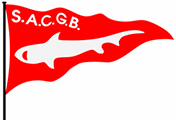March 1973 Newsletter Highlights
Brian Tudor is still the secretary and the headquarters is on The Quay in Looe
He introduces the newsletter by referring to the cold water temperatures the previous year which was believed to be the reason for low Blue shark numbers. The one positive about the previous season was that the clubs financial position had improved, and subscriptions had not been increased. However, the committee had decided to remove the buffet from the AGM but since it was an anniversary year there would be a Cabaret.
Boat prices had increased and was in line with the general cost of living.
The tagging programme managed by the club honorary biologist was planned to continue this season (details of the programme below)
The club introduced a visitors book at HQ and also in the Shark Bar at the Hannafore Point Hotel.
Blazer badges had increased to £4 and cap badges to £3……
Members were encouraged to book their place at the Annual Dinner early as since it was the 21st Anniversary, a good level of interest was expected. Seating arrangements were limited to 170 which was smaller than previous years.
Shark Tagging – the programme had started in 1972 and was run by the Marine Laboratory in Plymouth by the SACGB honorary biologist, Dr. Q Bone and Mr John Stevens of the Marine Laboratory.
In spite of the very poor season in the previous year, 350 sharks were tagged. These were mainly Blues but a few Porbeagles were tagged by skippers in Portugal, Looe, Mevagissey, Falmouth, Penzance, Newquay and Salcombe.
Mr Stevens addresses the belief of some that tagged sharks don’t survive by reminding people that as with any animal which does not stay in one location all their lives the expected return rate of tags will be low and within the range of 1%.
The Ministry of Agriculture were therefore not unhappy with receiving two returned tags from 200 tagged sharks.
The Inland Fisheries Trust Incorporated had been tagging sharks off Ireland and had managed to tag 380 Blues in the previous season. It was hoped that some of that number would find their way to the Channel this season.
On the other side of the Atlantic from 1967 to 1969 the Narragansett Laboratory, supported by anglers tagged 3050 Blue sharks. The maximum time at liberty for a shark was 2.7 years and the maximum distanced travelled was 2,700 miles. The fastest rate of travel was 27 miles per day by a shark which had travelled 1,720 miles in 64 days. Their data showed that sharks regularly migrate the 2000 miles between New England and South America.
It was believed that the Channel Blue sharks probably migrate northward from the Canary Islands. However, at the moment their movements and growth rates in our waters remained a mystery.
Annual Report – the previous year was a very poor one in terms of shark numbers. The number in 1971 was 4651 and in 1972 this had fallen to 1753.
In spite of this the popularity of the club did not suffer as there were fewer resignations than in 1971.
There was good news as well. Don Cowans 296lbs Porbeagle caught on 130lbs line class tackle had been awarded World Record status. Four other British Records had been awarded. They were:
S James – 108lbs Blue in 12lbs Line Class
J Stevens – 88.5lbs Blue in 20lbs Line Class
V Lister – 63lbs Porbeagle in 12lbs Line Class
Miss S Ward – 187lbs Porbeagle in 80lbs Line Class
It was noted that the interest in Line Class Records was continuing to grow.
